Observations on London Fashions April 1885
The leading styles for Spring appear to be now settled, but we are fain to confess that there is nothing very new or very original about them at present. What the more advanced season, settled weather and warmer days may do, remains yet to be seen; at present, it may be said that a lady can wear anything.
However, this remark, which has grown from oft repetition into a truism, must be accepted with, the proverbial grain of salt, and above all, it must be acted upon with scrupulous care, forethought, and discretion.
A lady can wear anything, yes— anything that becomes a lady, and every female of good taste may at present allow her excellent taste full scope without fear of "being out of fashion," whatever be the style of dress in which she chooses to appear.
However, good taste, by which we mean artistic taste, educated taste, refined taste, and above all, quiet taste, must reign supreme.
No extravagances must be indulged in, no humpy sleeves, no excessive distention of the back draperies, no violent contrasts of color; and in the street, the blending of even harmonious shades must be used cautiously.
Blending of color and arrangements of drapery which harmonize, are in perfect keeping with a drawing-room or artistic boudoir, and can be worn with propriety in a carriage, are out of place on the promenade, or at a railway station, and on these occasions, it is the “quiet” dress, subdued in tone, and not remarkable in cut, which points out the lady.
Our Journal has for many years been the recognized medium for the diffusion of those quiet and elegant styles which now more than ever mark in her dress the English gentlewoman, and our plates for this month show that our aim to lead taste in this direction is very faithfully followed.
Plates 1, 2 and 3 contain the latest ideas in style and color both for home and promenade dresses and are full of interest to the dress wearer and dressmaker, enabling the one to see at a glance the style which will best suit her own taste, and giving unusual facilities to the other in the art of making up the costume selected.
On plate four, will be found our half-yearly Mantle Plate, which has been prepared this season with exceptional care to suit the requirements of our largely-increasing supporters.
A glance at it, and at the opposite views of the garment on plate 7, will give our readers a just and precise idea as to the styles of outdoor clothes for the coming season.
The new and elegant cape, an illustration of which is shown on page 3, is likely to be an immense favorite. It can be made in any material and affords excellent scope to ladies of artistic proclivities in its embroidery, or other ornamentation.
Black is often worn this season, not only by those in mourning but from choice. It is not unnatural that this should be so, as there are many reasons why the somber hue should be chosen when the wearer herself has not lost a relative.
The fearful thinning of our ranks in Egypt, the private bereavements in many noble families, the appalling disaster at Shoeburyness, in which two brave officers found a violent death without the glory usually attendant on a soldier's passage to the great Beyond, have affected public taste.
Moreover, though life and society must go on, as usual, signs of these calamities are observable in the costumes exhibited on many occasions.
However, black, though it is somber, need not be doleful wear.
Jet is abundantly used to brighten black dresses, both for day and evening costumes, and for the latter, color may be introduced advantageously in loops or rosettes of ribbon, tufts of feathers, or bunches of flowers.
A plain black dress, either of silk, satin, or velvet, might permanently be smartened up by adding to it a jetted tablier and plastron.
These elegant adjuncts to a toilette may be made at home if the wearer-to-be is smart and patient, and in this case, the cost of materials is almost nominal compared to the effect.
However, those who do not care to be troubled can procure the tablier and plastron in elegant designs from Messrs. Hayward, of Oxford Street.
White is much worn for evening dress and is likely to be very fashionable for day wear, as the season advances, and the time for garden parties and outdoor fries is at hand.
Black and white used together are a combination also coming into favor, especially in lace arrangements. For instance, black lace over white will be seen, a revived fashion, by-the-bye.
There are also several new materials in black and white stripes, such as satin and plush, satin and ottoman, velvet and silk, etc., while for evening toilettes we have seen an elegant fabric composed of alternate stripes of black satin and white gauze ribbon with a satin edge.
Dresses for general wear are still composed of woolen in some form, arranged with more luxurious materials such as plush, velvet, or broché, but the latter is much more sparingly used than of old, the more everyday fabrics seeming more in favor.
Plain silks, in particular, are likely to be seen more frequently than they have been for many years, and the same is to be predicted of Irish poplins.
No doubt a great impetus will be given to the poplin trade by the gracious order given by Her Majesty for several dresses for Princess Beatrice's trousseau.
For an evening dress, there is a decided revival in favor of crepe as a leading material, which, as crape is English manufacture, should be earnestly encouraged.
Many of our principal élégantes have adopted the idea more than one presentation gown has been prepared of soft white crape, draped over satin or velvet, which leave nothing to be desired in appearance.
For the newest ideas in Millinery, we beg to refer our fair readers to Plate 8, and to the separate paragraph on the subject.
Description of the Plates of Costumes
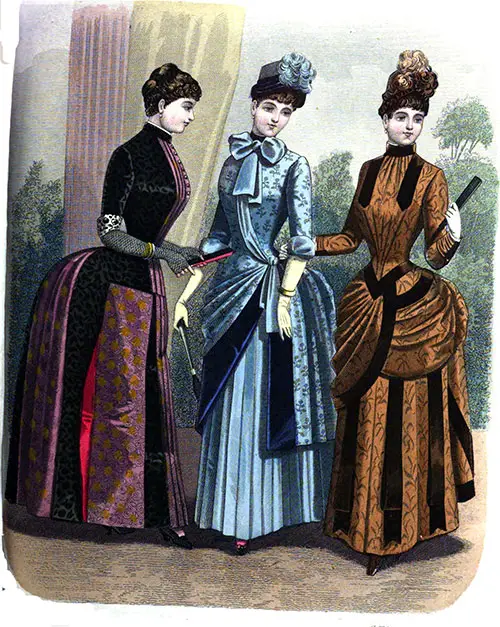
Plate 1: Promenade Costumes
Fig. 1. — (469). — Promenade Costume made of broché velvet and broché silk. The body is made slightly pointed in front, round at the back, with one panel attached to it on each side. The gilet is pleated and made of broché silk.
The skirt consists of two pointed pieces of velvet in front, divided by pleatings of silk, then a broad breadth of silk, a panel of velvet laid flat, and lined with crimson silk or satin. The back is made with two breadths of broché, separated by a thickness of velvet; all three fastened on the body by large gathers.
Will take 6 1/2 yards of broché silk; 4 1/2 yards of velvet; 24 buttons.
Fig. 2. — (470). — Promenade Costume of plain and broché blue silk trimmed with velvet. The polonaise is elegantly draped on the left side and embellished by a revers of fine velvet.
The back is laid in large pleats, starting close to the waist. The underskirt is pleated from waist to edge. Will require to make, 8 yards of broché; 4 1/2 yards of plain silk: 1 1/2 yard of velvet.
Fig. 3. — (471). — Promenade Costume of oak broché woolen trimmed with velvet. The body is pointed back and front, and may be fastened on the front, back, or side.
The overskirt consists of crossed draperies trimmed with brown velvet. The back is elegantly draped on a skirt laid in deep box pleats, and decorated with bands, loops, and ends of velvet. Will take 14 yards of broché; 4 yards of velvet.
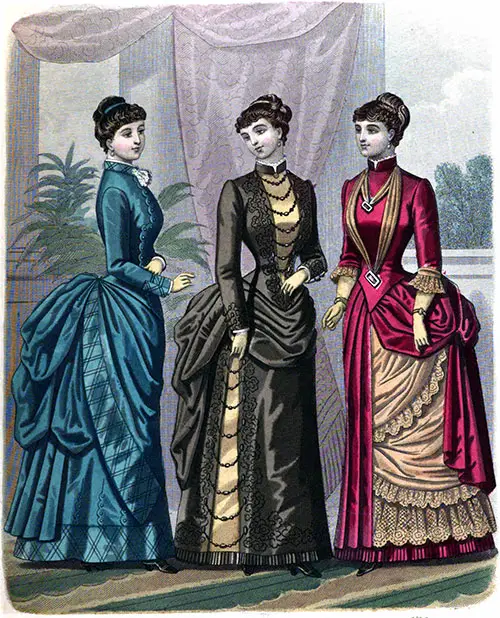
Plate 2: Promenade and Afternoon Costumes
Fig. 1. — (472). — Promenade Costume of blue cashmere trimmed with plaid. The body is pointed back and front with a plastron gilet scalloped at each button-hole.
The overskirt is draped very high on the right side and likewise on the left side and is trimmed by a large revers of plaid on the right side. The back is well draped on a skirt trimmed with a band of plaid buttons and scalloped button-holes.
Will require 12 yards of material: 2 yards of plaid; 5 1/2 dozen buttons.
Pointed Body with Plastron (472.)
The pattern given with this month's number is that of the elegantly pointed corsage shown on fig. 1 of our second plate. The design is given complete, and consists of seven pieces, via.: — front, sidepiece of the front, back, sidepiece of back, plastron, collar, and sleeve.
The front and side-piece of the front are each marked by two cuts near the armhole, showing where they are to be joined together. There are two notches on the front edges of front and plastron, indicating how they should meet each other.
The back and Bide-piece are joined to each other, and to the front, in the usual manner. The collar is of the upright stand form, and the sleeve has rows of pricking to indicate its underside.
Fig. 2. — (473). — Promenade Costume of chocolate silk trimmed with straw-colored satin and passementerie. The body is pointed back and front with a gilet of satin, trimmed at each side with passementerie and Brandebourgs (transverse cording and tassels in a military style).
The overskirt forms a very short drapery in front which is carried to the back, where it is very bouffant. The skirt is plain, trimmed with panels of satin, Brandebourgs, and passementerie, and edged by a narrow plissé.
Will take 12 yards of silk; 2 yards of satin; 8 yards of passementerie; 24 Brandebourgs.
Fig. 3. — (474). — Afternoon Costume of cerise satin trimmed with buff voile and lace. The body is pointed back and front, trimmed with écharpes (a fashionable trimming that consists of a broad band of gauze) and buckles.
The overskirt is of plain pleated silk, draped on the left side, and made bouffant at the back. The underskirt is made of voile draperies trimmed with lace.
Will take 10 yards of satin; 4 yards of voile; 4 yards of narrow lace; 2 yards of wide lace.
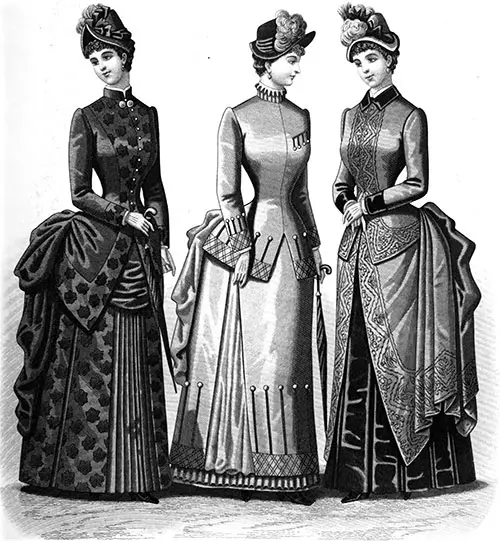
Plate 3: Promenade, Afternoon, and Traveling Costumes
Fig. 1. — (475). — Promenade Costume of black silk and velvet embossed on satin. The jacket or polonaise body is trimmed with a velvet gilet, and velvet border is sewn at the edge of the small pannier.
The back is long and bouffant. The skirt is crossed at the top by a sash drapery, ending under the bouffant at the back. It is pleated in front with half breadths of velvet (separated by a Bourlet (ropes intertwined around the masts and yards to hold the yards) of silk) sewn all around.
Will require 8 1/2 yards of silk; 5 yards of velvet; 12 buttons.
Fig. 2. — (476). — Traveling Costume of dust-color cloth, trimmed with plaid, cord, and buttons. The jacket is made long and round, opened at the back to allow the bouffant to show through; plain skirt with a bouillonné at the side, and trimmed all around with plaid, cord, and buttons.
Will require 12 yards of material; 1 1/2 yards of plaid: 18 yards of cord; 48 buttons.
Fig. 3. — (477). — Afternoon Costume of black embroidered cashmere and velvet. The jacket is made round, and slightly open in front below the waist. It is embroidered all around.
The overskirt is opened in front to show the pleated velvet skirt; it is then draped high on the hips, in a double box pleat, and made very bouffant at the back. Will require 8 yards of embroidered cashmere; 41 yards of velvet.
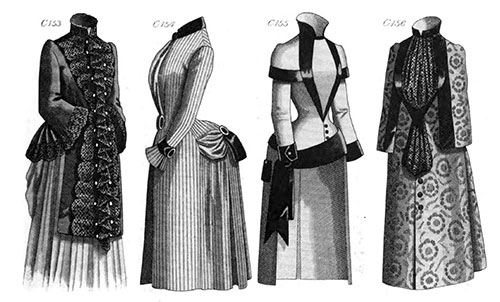
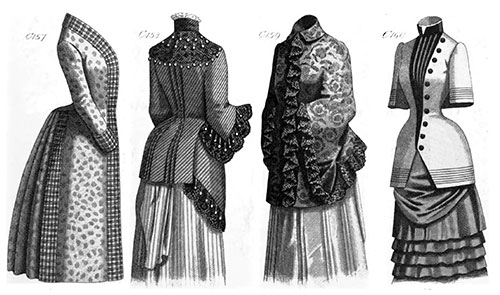
Plate 4: Special Plate of Ladies' Mantles, Jackets, Etc. For Spring and Summer, 1885.
Top Row:
Fig. 1. — (C153). — The Louison Visiting Costume made of silk, trimmed with lace and passementerie. The lace is sewn on in the shape of a plastron gilet, with long ends in front. The back is tight to the waist and then pleated and edged with lace. Will take 3 yards of silk: 10 yards of lace; 2 yards of passementerie.
Fig. 2— (C 154). — The Constance Coat, made of satin and velvet stripes, of a light-brown color. It is perfectly tight-fitting and is trimmed with a gilet of silk. It has velvet collar, cuffs, and bows. Will take 10 yards of material; 3/4 yard of velvet; 5 buckles.
Fig. 3. — (C 155). — The Paris Summer Coat made of grey colored silk. It has an open gilet, and the front skirt is also open to allow the costume to be shown through. It is ornamented with velvet collar, scarf, pocket, cuffs, and revert. Will take 7 yards of silk; 3 yards of velvet; 6 buttons.
Fig. 4. — (C 150). — The Lymington Pelisse for evening or carriage wear, made of brocade, trimmed with velvet. The front is ornamented by a lace gilet, velvet collar, and revere. Will require 11 yards of brocade; 1 1/2 yards of velvet; 3/4 yard of lace.
Bottom Row:
Fig. 5. — (C 157). — The Windsor Coat of light buff brocade trimmed with velours croisé. In front it is made with a shawl opening; the back is laid in large gathers. Will require 10 yards of brocade; 2 yards of velvet.
Fig. 6. — C 158. — The Dewdrop Visiting Costume of thick ribbed silk, trimmed with lace and passementerie. It is short at the back, laid in box pleats, and is long and pointed in front. Will take 7 yards of silk; 8 yards of lace; 84 yards of passementerie.
Fig. 7— (C 159). — The Camilla Visite Mantle made of brocade or lace. It is long in front, short at the back, with very deep sleeves, and is trimmed with lace. Will require 5 yards of brocade; 12 yards of lace.
Fig. 8. — (C 100). — The Voyageuse Short Coat with a cape instead of sleeves, trimmed with a pointed pliant gilet and large buttons. It is edged with eight rows of narrow cord. Will take 3 yards of cloth; 10 buttons; 3/4 yard of velvet; 24 yards of cording.
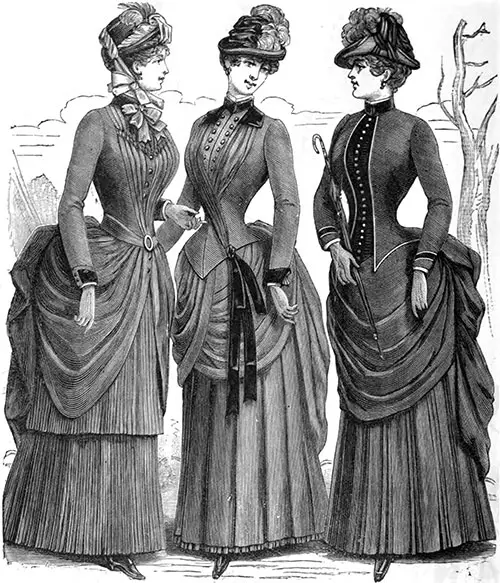
Plate 6: Outdoor Costumes
Fig. 1. — (478). — Outdoor Costume of black cashmere trimmed with velvet. The polonaise body is embellished with a pleated gilet, fastened at the waist by a band.
The fullness of gilet forms the fullness of overskirt, which is opened in the front and is very bouffant at the back. The skirt is made of two plissé flounces. Will require 14 yards of cashmere; 18 buttons; 1/4 yard of velvet.
Fig. 2. — (479). — Outdoor Costume of brown woolen trimmed with velvet. The body is pointed back and front and decorated with double rows of buttons and a scarf gilet and velvet collar.
The upper skirt is made of two crossed draperies well puffed at the back, over a skirt laid in deep pleats. Will require 12 yards of material; 1/4 yard of velvet; 3 yards of ribbon velvet; 18 buttons.
Fig. 3. — (480). — Tailor-Made Costume of green cloth trimmed with velvet. The Jacket is opened in front to show the velvet gilet; the back forms a coat-tail. The overskirt is draped en tablier in front and is very bouffant at the back over a pleated skirt.
Will require 10 yards of cloth; 3/4 yard of velvet; 18 buttons.
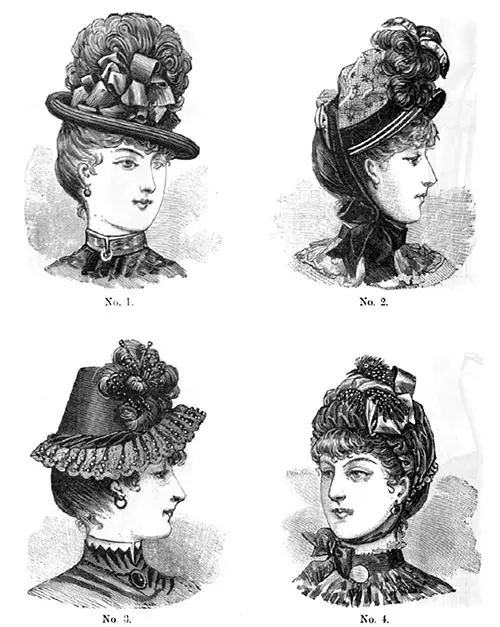
Plate 8: Two Hats and Two Bonnets
- The first, a hat, is made of straw lined with velvet, trimmed with Ottoman ribbon and feathers.
- The second, a bonnet, is made with velvet and lace, trimmed with feathers and ribbon. It is tied under the chin.
- The third, a hat, is made of straw trimmed with velvet, beaded lace, and a handsome aigrette.
- The fourth, a bonnet, is made of satin to match the toilette, trimmed with ribbon and a bird's bead and wing.
"Observations on London Fashions," and "Description of the Plates of Costumes," in London and Paris Ladies Magazine of Fashion, Literature and Fine Arts, London: Kent & Co. Vol. 58, No 652, April 1885, p. 1-5.
Editor's Note: Some terminology used in the description of women's clothing during the 1800s and early 1900s has been changed to reflect more modern terms. For example, a women's "Toilette" -- a form of costume or outfit has an entirely different common meaning in the 21st century. Typical terms applied to "toilette" include outfit, ensemble, or costume, depending on context.
Note: We have edited this text to correct grammatical errors and improve word choice to clarify the article for today’s readers. Changes made are typically minor, and we often left passive text “as is.” Those who need to quote the article directly should verify any changes by reviewing the original material.

